Peace lilies are by far one of the most popular houseplants to grow because they are low maintenance and fairly easy to care for.
They can be a bit fussy though, so it’s very important to understand what they need to thrive. Once you get the hang of it, you’ll be able to enjoy them for many years to come.
In this complete care guide, I’ll show all you need to know about how to grow peace lily plants. Including details about water, soil, light, fertilizer, pruning, flowering, propagation, pest control, and much more.
Quick Peace Lily Care Overview
| Scientific name: | Spathiphyllum |
| Classification: | Tropical plant |
| Common names: | Peace Lily |
| Hardiness: | Zones 11+ |
| Temperature: | 65-80°F |
| Flowers: | White, can bloom year round |
| Light: | Full to partial shade, bright light indoors |
| Water: | Keep soil evenly moist, do not overwater |
| Humidity: | Average to high |
| Fertilizer: | General purpose plant food spring-summer |
| Soil: | Fast-draining, fertile soil |
| Common pests: | Spider mites, mealybugs |
Information About Peace Lilies
The peace lily (Spathiphyllum) is a very common indoor plant with lovely green leaves and stunning white flowers. It’s in the Araceae family, along with dieffenbachia plants and Chinese evergreens.
Though they are native to the tropical areas of North and South America and parts of Asia, they can easily adapt to growing indoors.
Commonly gifted as sympathy plants, they’ve gained a lot of attention in the past few years because they are air purifying houseplants.
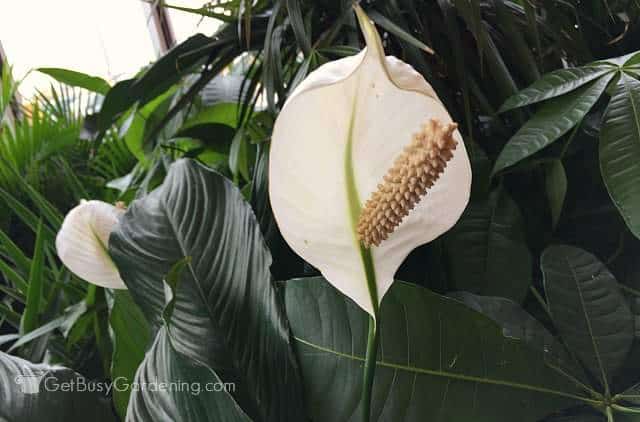
Different Varieties
There are several different types of Spathiphyllums, and they all require the same care. They look very similar to each other, but come in a range of sizes and foliage hues.
The sizes can be anywhere from the small varieties that only grow to be a few feet tall, to huge floor plants that are several feet tall. The leaf colors range from very dark to light green, or variegated.
Toxicity
All parts of the peace lily plant can be harmful if eaten. According to the ASPCA, they are toxic to cats and dogs.
If you have pets or small children around, then it’s best to keep this one out of reach. Otherwise, if you don’t want to risk it, check out my list of pet friendly houseplants.
Flowers
Most peace lily plants will bloom from spring through summer with the proper care. They are prized for their distinctive white flowers that stand above the foliage on tall stems. It’s the feature that most people recognize first.
They need lots of bright, indirect light to bloom. Once they’re done flowering, they usually have a rest period during the fall and winter months.
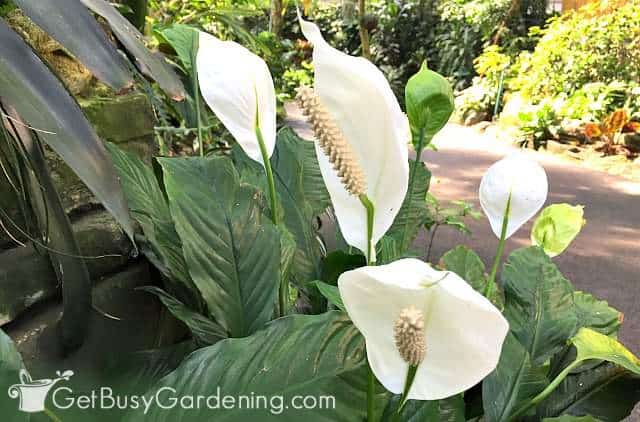
Peace Lily Care & Growing Instructions
Growing a peace lily isn’t difficult, but it’s important to give your plant the proper care so it will stay healthy and happy. Follow my detailed tips below for the best success.
Water
Proper watering is one of the most important parts of peace lily care, and giving them too much is their #1 cause of death.
They prefer to dry out slightly between waterings, and won’t tolerate wet feet for long. Push your finger 1-2 inches deep into the soil. If it feels damp, then don’t add anymore water. Use a moisture gauge to make it easy.
When it’s time, give your plant a deep drink, and allow the excess to drain completely out of the bottom of the pot – never leave it soaking.
It’s important to note that peace lilies are sensitive to the salts and chemicals in tap water. These additives can cause yellow or brown leaves, tips, and margins. So use distilled, filtered, or rainwater on them if you can.
Humidity
Since they come from tropical areas, peace lilies like a lot of humidity. They can adapt fairly well to lower levels, but extremely dry air will cause brown leaf tips and edges.
You can increase it by running a humidifier nearby or misting the leaves regularly to see if that fixes the problem.

Light
Peace lilies make great low light houseplants because they actually don’t like any direct sunlight. Too much sun will cause the leaves to fade, turn yellow, and/or burn.
However, they won’t grow well or bloom if it’s too dark. They need bright light, and filtered or indirect are the best.
Somewhere near a bright window or in a sunny room would be the perfect spots. If your home is too dark, then you can add a grow light.

Soil
Peace lilies aren’t fussy about the type of soil you use, any high quality general purpose mix will work just fine. But they do prefer one that drains well.
If you tend to overwater, you can mix in some perlite, pumice, or coarse sand to increase drainage. They also like it slightly acidic, between 5.8 and 6.5 is a good range. You can use a probe tool to test it.
Repotting
Another thing that makes a peace lily so easy to care for is that they like to be pot-bound. In fact, they really hate being repotted.
So you should only repot yours if it’s absolutely necessary. When the time comes, it’s best to do it in the spring.
Also, make sure the new pot isn’t much bigger than the old one. They don’t like having too much space, so you should only go up one or two sizes. And always be sure to use a container that has drainage holes in the bottom.

Fertilizer
Peace lilies aren’t heavy feeders, but you should fertilize your plant a few times during the spring and summer months to encourage fresh new growth and flowers.
However, they are very sensitive to synthetic fertilizers. These harsh chemicals can cause major problems, like burning the roots, or making the leaf margins and tips turn yellow or brown.
I recommend using organic products instead. A few of my favorites are liquid compost tea, indoor plant food, or general purpose granules.
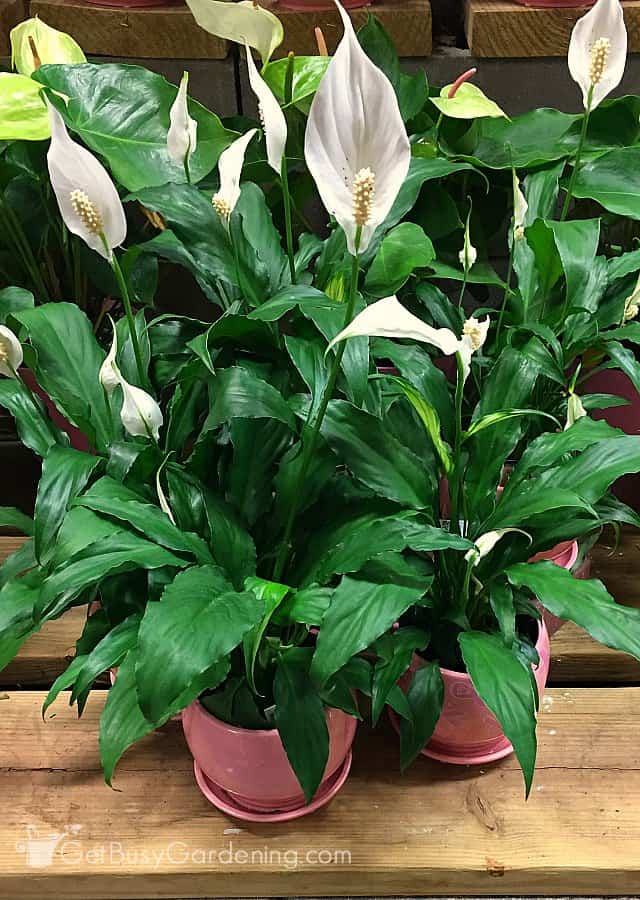
Tips For Controlling Pests
Healthy peace lily plants rarely have problems with bugs. But sometimes spider mites or mealy bugs can attack them.
If you find these pests, treat the leaves right away. Organic neem oil is a natural insecticide that is very effective at getting rid of them, and I highly recommend it.
Soapy water spray is also great for controlling pests. You can buy an organic insecticidal soap, or use a mixture of 1 teaspoon mild liquid soap per 1 liter of water.
Related Post: How To Get Rid Of Houseplant Bugs Naturally
Pruning
To keep your plant tidy and looking its best, you can prune it as part of your regular peace lily care routine. Here are some pointers:
- Remove brown leaf tips and edges by trimming them at an angle following the natural shape of the leaves.
- Cut dead or dying foliage all the way down to the base of the plant.
- Prune out faded or brown flowers and stems to help encourage more blooms.
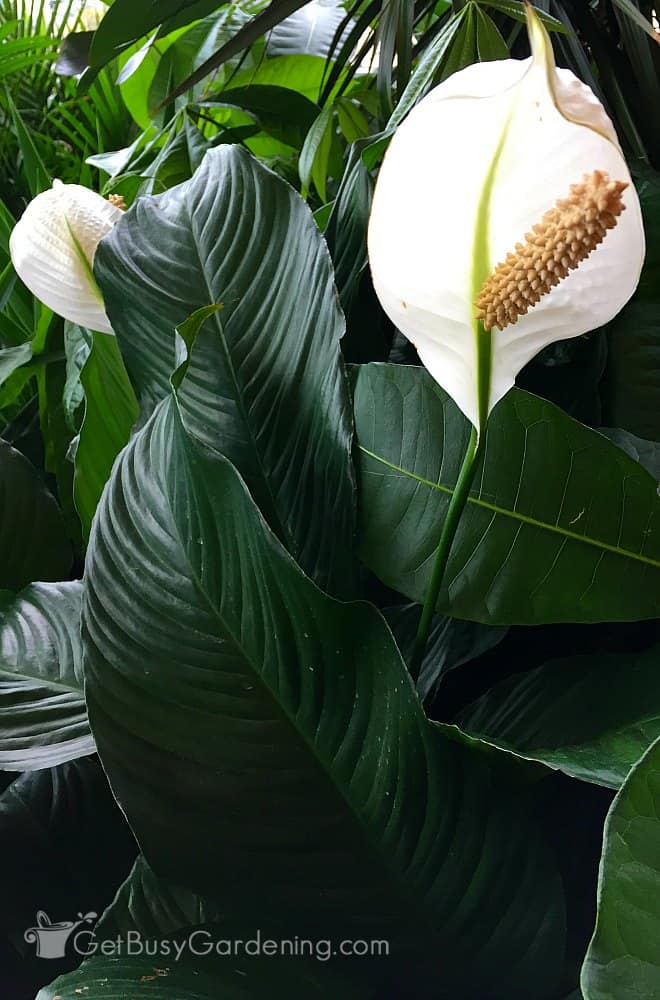
Peace Lily Propagation Tips
The only way to propagate a peace lily is to divide the rootball. To do this, remove it from the pot and gently untangle the roots – carefully working to separate the offshoots from the main plant.
If the rootball is really thick and dense, you may need to use a knife to cut it apart. Just be sure that each individual stem has roots, or it will not survive on its own.
Troubleshooting Common Problems
Peace lily care can be a bit daunting when your plant starts having problems and you don’t know why. Here’s a list of some of the most common issues, and tips for how to fix them:
Plant Is Drooping
Drooping is usually caused by over or under watering. But it can also be from sudden changes in temperature, or transplant shock after repotting.
If you recently moved it to a new pot, it should recover in a few days. Otherwise, check the soil and only water if it’s dry. Move the plant if it’s in direct sun, near a heat source, or exposed to a cold draft.
Leaves Turning Yellow
It’s normal for the older bottom leaves to turn yellow as they die, so you can simply prune those off. But if others are yellow, or there are several of them that turn at once, then it’s probably from overwatering or bugs.
Inspect the leaves for pests, and check to make sure the soil isn’t overly wet. It should dry 1-2″ deep between drinks.
No Flowers
The most common cause of a peace lily not blooming is inadequate lighting, they need bright light to flower.
Feeding your plant during the spring and summer, and regularly deadheading spent flowers will also help encourage blooming.
Brown Leaves Or Leaf Tips
This is almost always caused by improper watering, lack of humidity, or chemical damage from using tap water or synthetic fertilizers.
A yellow or white crust on top of the soil or around the inside pot edges are telltale signs of a salt or chemical buildup. Try using distilled, filtered, or rainwater instead, and switch to an organic fertilizer.

FAQs
Peace lilies can only live outside year-round in the warmest most tropical climates of zones 11+. They are extremely sensitive to cold weather, so if you choose to put yours outside during the summer, be sure to bring it back indoors before it drops below 65°F.
The most common cause of death for peace lilies is overwatering. The soil should dry 1-2″ deep, and never feel wet or saturated. Other common reasons are from chemical fertilizer burn, or prolonged exposure to hot or cold drafts.

Now that you’ve learned exactly how to care for a peace lily, you’ll be able to enjoy your plant for many years to come. I know it can seem overwhelming, but you’ll get the hang of it in no time.
If you want to learn all there is to know about maintaining healthy indoor plants, then you need my Houseplant Care eBook. It will show you everything you need to know about how to keep every plant in your home thriving. Download your copy now!
More Plant Care Guides
Share your peace lily plant care tips in the comments section below.

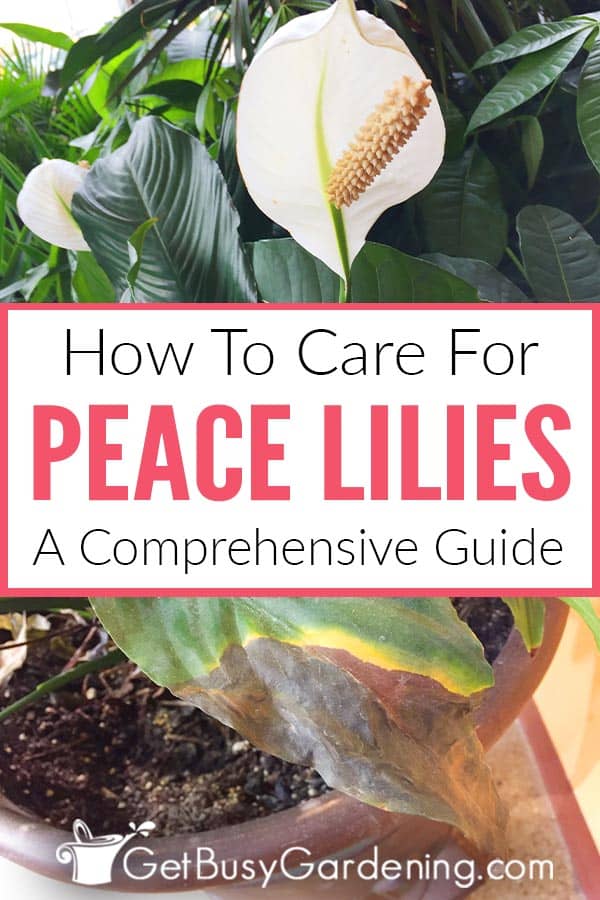
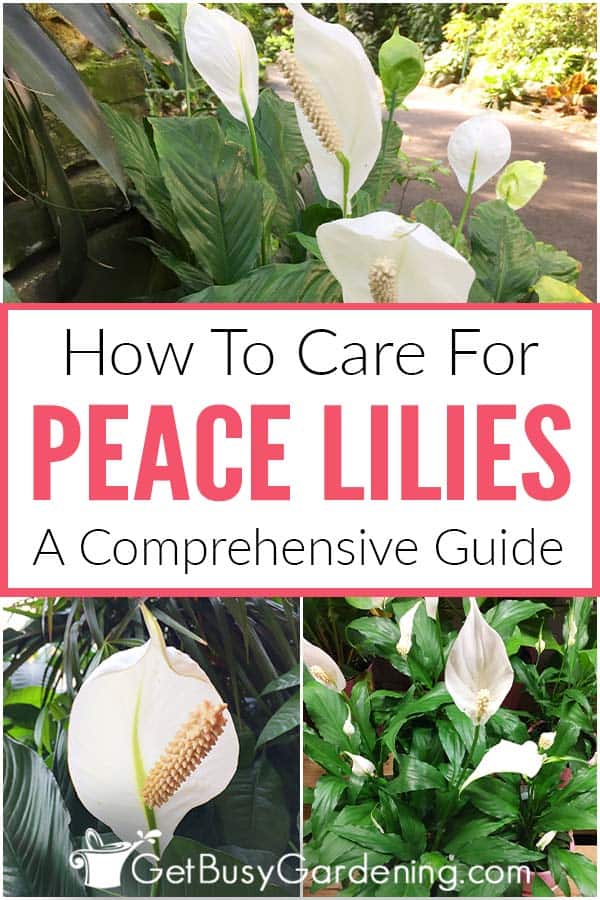



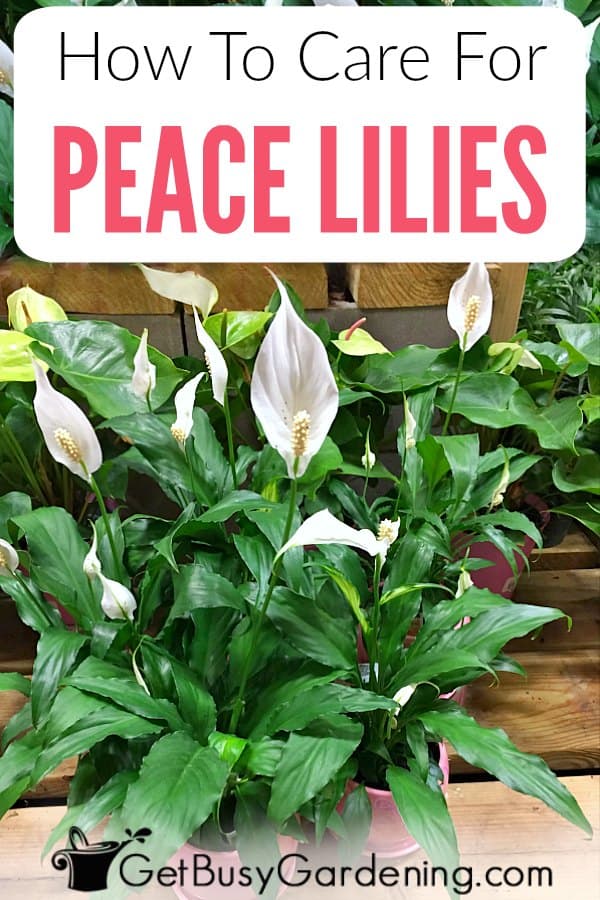




Crystal says
Hi Amy, Thanku for sharing ur knowledge, and Thanku for answering all the questions that is helpful too.
My question is can I cut the whole plant down to the soil and try to start over? Mines seemed to die after I put it outside on a couple of sunny days.
Amy Andrychowicz says
You’re welcome! Sorry to hear about your ailing peace lily! If there are any green leaves on the plant, then I would leave those growing, and prune out only the dead leaves. If all of the leaves on the plant have died back, then you can try cutting it back and see if it will regrow. Be sure to check the soil to see if it’s overwatered, and make sure you allow it to dry out slightly between waterings. Peace lilies will burn in full sun, so it’s best to keep them indoors. If you want to move it outside again, then be sure to choose a shady spot for it.
Danielle DellaVecchia says
HI, can you divide a peace lily?
Amy Andrychowicz says
Yes, peace lily propagation is done by division. Many times there are offshoots on the sides of the rootball that are super easy to separate from the mother plant. Just be sure that each of those offshoots has it’s own root system before separating it from the main root system.
Deb Boyle says
I was at first starting to distress reading your comments about overwatering.
I had a Peace Lily which overgrew its 24”round x 30” deep not.
So much so I tore it all apart, separated many of the roots, then cut all thier roots back.
7 new 12 x 12” pots of Peace Lily’s later, I still had several starter roots and small break-offs left!
I started experimenting and have had a huge success growing Aquadic pieces of art.
They include ideas such as driftwood, a few with sunken rocks with algae and the
Lily’s.
Gold fish, and or beta fish love the rooting systems.
So grow Peace Lily’s in water has been so, so easy for me.
But thank you so much for your advice?
Amy Andrychowicz says
You’re welcome. Yes, growing peace lilies in water is different than overwatering plants that are growing in soil. 🙂 Sounds like you’re having fun experimenting!
Angela says
HI,
I have a peace lily in my home and it is thriving! But it contradicts everything you are saying it doesn’t like. Mine is in a vase of water with a fish living underneath it. It is also in a very bright living area with lots of sunlight. You say to not overwater the plant when mine is obviously doing great in only water. Can you tell me how mine is thriving?
Amy Andrychowicz says
Yes, peace lilies can be grown in water, and they love bright light too… just not intense direct sunlight (like from a south facing window).
Lori says
Hi Amy
Thanks for your reply in advance. Can I plant a money tree with a peace lily. Does peace lilies like to be pot bond or the bigger the room the better.Lori
Amy Andrychowicz says
It might be ok, as they do have similar care requirements, however they will probably quickly outgrow the peace lily. And yes, peace lilies do like to be pot-bound. Here’s how to care for a money tree plant.
Louise says
I have a peace lily plant for 2 years.
It’s healthy but I don’t get it to bloom.
Why won’t my peace lily flower ?
What should a do ?
Thank you
Amy Andrychowicz says
Give it more light. Peace lilies need bright light in order to bloom, so move it to a location where it gets more natural light, or add a grow light. Never give your plant direct sunlight though, or it will burn the leaves.
Gurdeep says
can i grow peace lily in water?
Amy Andrychowicz says
I have never tried growing peace lily in water myself, but I have seen them growing in water before. You could experiment with it and see how well it works for you. Just make sure to keep the water clean by refreshing it on a regular basis. I have a feeling that peace lilies growing in water probably won’t live as long as the ones growing in soil, but it would be a fun experiment. 🙂
Cheryl says
Hello, I have a peace lily that does not bloom, but instead puts off leaf clusters. These clusters grow to be about 6″ tall, and then they die. Is there something I am supposed to do with these sort of off shoots?
Amy Andrychowicz says
Are you sure they aren’t green flowers? Sometimes peace lily flowers turn green rather than white. Otherwise, are the leaves stuck together or deformed? Sorry, but I can’t visualize what you mean by “leaf clusters”.
Debbie says
I have my plant for almost 4 years. It had blooms on it when I first got it but has never bloomed since. Otherwise is doing great. Why won’t my peace lily bloom, and how can I get it to bloom?
Amy Andrychowicz says
Try giving your peace lily more light. Don’t put it in full sun, but move it closer to a sunny window, or put it in an east or west facing window. Also, try fertilizing it a few times during the spring and summer, that may help to give it a boost and encourage flowering. Just make sure you don’t use a harsh chemical fertilizer (see the “Fertilizer For Peace Lily” section about fertilizer above for more details).
Bre says
My peace lily died during the winter and I have recently tried to revive it by cutting all the dead and brown leaves on it but the tips keep turning yellowish brown everytime I cut them and are droopy . It’s in a self watering pot so I don’t know if I’m over or under watering it . I have new leaves growing but the tips are brown before it blooms. What is wrong with my peace lily , and when will I start to see new lilies PLEASE HELP!!!!
Amy Andrychowicz says
From your description, my guess is that your peace lily is being overwatered. First thing to do is check the soil. Stick your finger down at least one inch into the soil, and see if it feels damp at all. That will tell you whether you’re over or under watering it. See the “Peace Lily Water Requirements” section above for details about that, and also the “Troubleshooting Common Peace Lily Problems” section above to see if there may be something else going on with it.
Melanie Walker says
I have a peace lily that I’ve had for a couple of months. It’s doing pretty well but I was wondering about the blooms that have now died out. Is it safe to prune? And if so, what are your recommendations for how to prune peace lily flowers safely and still preserving the plant and chances of blooming again?
Amy Andrychowicz says
Yes, it’s safe to prune peace lilies once the flowers have faded. Simply clip the flower stalk off at the base (or as low as you can get on the flower stem).
Melanie Walker says
Wonderful! Thank you for your help!
Wanda says
I’ve had a Peace Lilly that has thrived for over 5 years. Unfortunately, it has just recently started looking pitiful. Some of the leaf tips are turning brown but also the new growth is turning brown before the leaves have a chance to open completely. Why are my peace lily leaves turning brown? It’s been in the same pot since I’ve had it. Do I need to re-pot it? Or is something else going wrong with it?
Thanks
Amy Andrychowicz says
Brown tips on the leaves of peace lilies can be caused by many things, or even a combo of things. Go through the list above under the section “Troubleshooting Peace Lily Problems” and see if you can pinpoint the possible issue(s). Repotting is stressful for the plant, so I don’t recommend repotting a plant that’s struggling until you’ve ruled out all other possible issues. If you do decide it’s time to repot your peace lily, spring is the ideal time to do it.
Grace says
I have a pretty old peace lily. It was doing well for some time, probably a year or so. But the tips of the leaves get brown, and then the entire leaf dies, starting with the old growth. It is an indoor plant. I have tried changing water, soil, pot, and potting medium. Any ideas? Thanks!
Amy Andrychowicz says
Keep an eye on the soil moisture level and make sure you’re not overwatering it (especially during the winter months). Also, make sure it’s not exposed to any hot or cold drafts. Also, do you use fertilizer? Chemical fertilizers will build up in the soil, and peace lilies are very sensitive to them. They are also sensitive to the salts and chemicals in tap water, which can build up in the soil too. So try switching to filtered water or use rainwater. One other thing to check for would be houseplant pests. Closely inspect the leaves and make sure there aren’t any signs of bugs on your plant. Good luck!
Lyndal says
Hi! I have planted my Peace Lily in a pot with no drainage holes. Can you please advise the best way for me to water this without drowning it?
Thank you
Amy Andrychowicz says
Hi Lyndal! You’re definitely going to want to be careful, and check the soil every time you water. Stick your finger about 1 inch into the soil to make sure it’s not damp before you water your peace lily. If you’re really worried, you might want to consider getting a soil moisture gauge to help you out. If you end up struggling with it through the winter, then I would repot it in the spring into a pot that has drainage holes. Hope this helps!
Carol says
Why are my peace Lily flowers green and not white?
Amy Andrychowicz says
The flower color can range from white to green, and that’s a pretty common trait of peace lilies, especially certain varieties. The flowers start out green when they first start to grow, they will usually turn white when they open, and then they turn green again once the flower starts to age and fade. If your flowers never turn white, it could be caused by improper watering, light, and/or fertilizer. If it’s a brand new plant, then it’s probably still adapting to it’s new environment.
Summer says
Can you keep dieffenbachia in a planter with the peace lily? Like a funeral planter?
Amy Andrychowicz says
Yes, you sure can. They have similar growing requirements as a peace lily, so they will grow together well.